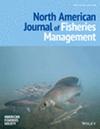大西洋蓝蟹罐取样中男性偏倚的证据
IF 1.4
4区 农林科学
Q3 FISHERIES
引用次数: 0
摘要
摘要目的大西洋蓝蟹(Callinectes sapidus)是美国南卡罗来纳州沿海地区价值最高的商业渔业之一,具有重要的生态和经济价值。南卡罗来纳自然资源部的研究人员使用各种装备进行了多次调查,以监测大西洋蓝蟹的状况。人口统计学特征通常会受到采样齿轮相关偏差的影响。方法我们比较了三个河口的被动的、基于锅的采样和主动的、基于拖网的采样在秋季的蓝蟹性比,以及在一个河口的全年采样(Ashley River, SC)。结果在秋季期间,盆式取样的男性取样率比拖网取样的男性取样率高20.1%。此外,在南卡罗来纳州阿什利河的全年采样中,总体男性偏差为23.1%;然而,这种偏差仅在某些月份显著。我们的研究结果表明,虽然特定的采样齿轮可能具有特定的优势,例如更适合于有效地采样某些栖息地,但所得的人口统计特征可能因齿轮类型而异。认识到与渔具相关的偏差对于确保实地调查具有人口统计学的代表性非常重要,特别是当使用特定性别的建模方法作为种群评估的一部分以确定种群状况时。本文章由计算机程序翻译,如有差异,请以英文原文为准。
Evidence for a Male Bias in Atlantic Blue Crab Pot‐Based Sampling
Abstract Objective The Atlantic Blue Crab Callinectes sapidus is an ecologically‐ and economically‐important species that supports one of the highest valued commercial fisheries in coastal South Carolina, USA. Researchers at the South Carolina Department of Natural Resources conduct multiple surveys to monitor the status of the Atlantic Blue Crab using a variety of gear configurations. Demographic characterizations can often be influenced by sampling gear‐related biases. Methods We compared blue crab sex ratios between passive, pot‐based sampling and active, trawl‐based sampling across three estuaries in the fall and for year‐round sampling in a single estuary (Ashley River, SC). Result During the fall, the percent of males collected in pot‐based sampling was 20.1% higher than the percent of males collected in trawl‐based sampling. Furthermore, an overall male bias of 23.1% was observed for year‐round sampling in the Ashley River, SC; however, this bias was only significant in certain months. Conclusion Our findings suggest that while particular sampling gears may have specific advantages, such as greater suitability to effectively sample certain habitats, the resulting characterizations of population demographics can differ among gear types. Recognizing gear related biases is important for ensuring that field surveys are representative of population demographics, particularly when sex‐specific modeling approaches are used as part of stock assessments to determine population status.
求助全文
通过发布文献求助,成功后即可免费获取论文全文。
去求助
来源期刊
CiteScore
2.60
自引率
18.20%
发文量
118
审稿时长
2 months
期刊介绍:
The North American Journal of Fisheries Management promotes communication among fishery managers with an emphasis on North America, and addresses the maintenance, enhancement, and allocation of fisheries resources. It chronicles the development of practical monitoring and management programs for finfish and exploitable shellfish in marine and freshwater environments.
Contributions relate to the management of fish populations, habitats, and users to protect and enhance fish and fishery resources for societal benefits. Case histories of successes, failures, and effects of fisheries programs help convey practical management experience to others.

 求助内容:
求助内容: 应助结果提醒方式:
应助结果提醒方式:


